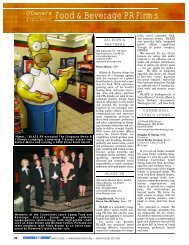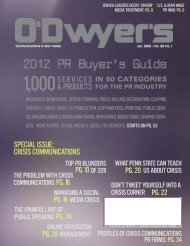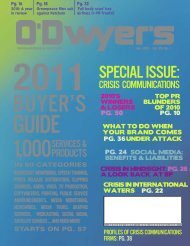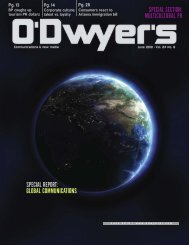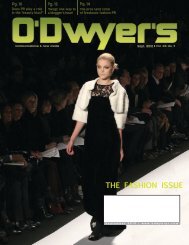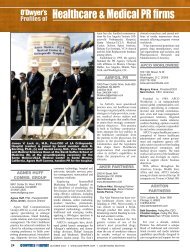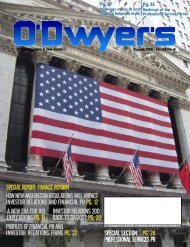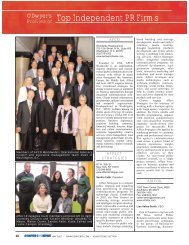May '11 PR Rankings Issue - Odwyerpr.com
May '11 PR Rankings Issue - Odwyerpr.com
May '11 PR Rankings Issue - Odwyerpr.com
You also want an ePaper? Increase the reach of your titles
YUMPU automatically turns print PDFs into web optimized ePapers that Google loves.
FEATURE<br />
Social media still has a long way to go<br />
Should we be putting this much emphasis on social media, or<br />
is the medium simply a fad that will later settle as just another<br />
public relations tool? By Debra Caruso<br />
I’m not convinced that the mega buzz in<br />
the public relations world — about the<br />
need to embark on social media campaigns,<br />
sometimes at the expense of what<br />
we have done traditionally — is justified.<br />
I would bet that major publications — both<br />
print and online — and broadcast outlets<br />
provide more bang for a client’s buck. It’s<br />
also very clear that clients are more<br />
impressed with “real” publications over<br />
mentions on the typical, independent blog.<br />
Bretton Holmes, Owner of Holmes<br />
World Media in Austin, Texas, emphasized<br />
that traditional media still works better.<br />
“No one as of yet has understood the<br />
best way to leverage social media. The fact<br />
is social will not work unless the traditional<br />
is effectively in place,” he said.<br />
Rodger Roeser, Owner of The Eisen<br />
Agency, referred to social media as “the<br />
new opiate of <strong>PR</strong> people.”<br />
“It is an activity they can <strong>com</strong>pletely<br />
control, and indeed, custom content is<br />
important, but it’s so cluttered and so overhyped<br />
that it lacks much impact or credibility.<br />
It can be great for leveraging a current<br />
‘hit’ in traditional media, but its overuse is<br />
a way many <strong>PR</strong> people and even firms justify<br />
their existence. Doing the work is far<br />
different than the work succeeding.”<br />
Many <strong>PR</strong> reps are delivering social<br />
media hits to their clients in lieu of stories<br />
and mentions in newspapers and on television<br />
where they’re generally seen by much<br />
larger audiences. Very few Tweeters and<br />
Facebookers have the audience that even<br />
the smallest metropolitan daily can muster.<br />
Some blogs have thousands of followers,<br />
but I’ve yet to see one not attached to a traditional<br />
newspaper that has the same<br />
impact.<br />
Gabrielle Rattner, a <strong>PR</strong> pro who owns a<br />
retail outlet in Brooklyn with her husband,<br />
said social media was enormously helpful<br />
in generating buzz and driving traffic to the<br />
store when their business first launched.<br />
“I would speculate that the format —<br />
short bits, a photo or two — were highly<br />
conducive to our [initially] limited inventory<br />
and short story,” she said. “However, a<br />
year later with our inventory dramatically<br />
expanded and our reputation more established,<br />
new media generated not one bit of<br />
traffic. Furthermore, the same firm we<br />
retained proved to have limited contacts in<br />
16<br />
MAY 2011 WWW.ODWYER<strong>PR</strong>.COM<br />
‘old’ media and little understanding of how<br />
to pitch traditional media; the hits we did<br />
get — on Web sites and Ezines — were<br />
worthless.”<br />
Added Rattner, “At the end of the day,<br />
new media may help reach a critical segment<br />
of the marketplace, but it is not a<br />
replacement for old media. For retail,<br />
nothing — nothing — replaces a squib in<br />
the Times.”<br />
Shirley Skeel, Media Relations Manager<br />
at the University of Puget Sound, said,<br />
“You just inspired me to look at my Twitter<br />
account, and ‘ho hum’ it’s still the same.<br />
90% is self-promotion, 9% rather interesting,<br />
1% brilliant. I will keep trying, but<br />
one-to-one contact with reporters in the traditional<br />
media with good, relevant story<br />
ideas is the most productive route I have<br />
found.”<br />
Messaging is still key. Brendan<br />
Kownacki, Director of Strategic<br />
Innovation of Merge Creative Media in<br />
Washington, D.C., says our industry colleagues<br />
“are putting too little focus on messaging<br />
and quality content. What we really<br />
need is an integrated approach where<br />
people know the value of both media<br />
worlds, ‘old’ and ‘new.’”<br />
“Twitter is an exercise to see if you can<br />
boil your message down into one short,<br />
sweet sentence,” said Kownacki. “The<br />
return on both forms of media is vast and<br />
powerful and each has the upper hand in<br />
different situations, but the meeting point is<br />
truly where you find maximum value.<br />
Each has value separately, but together<br />
they are priceless.”<br />
When Comcast was first buying NBC, it<br />
realized both corporate images were at<br />
stake. Comcast ramped up efforts to<br />
respond to irate cable subscribers that had<br />
taken to Twitter to vent about service problems.<br />
@<strong>com</strong>castcares helped to shape a<br />
positive image in a much more human way<br />
than any op-ed could have.<br />
Meanwhile, in the pharmaceutical space,<br />
<strong>com</strong>panies have tried to tiptoe their way<br />
online, but fear of legal entanglement and<br />
government oversight has restricted them.<br />
The FDA held hearings last year to try to<br />
decide on restrictions for online <strong>com</strong>munication<br />
among drug <strong>com</strong>panies and medical<br />
organizations, but couldn’t reach a consensus.<br />
Drug <strong>com</strong>panies, fearing negative<br />
feedback and liability, have engaged <strong>PR</strong><br />
partners to look at online media, but remain<br />
in the mainstream press where there is a<br />
healthy barrier to feedback.<br />
“I think the two examples show just how<br />
a hybrid approach could yield the best<br />
results,” said Kownacki. “Patient populations<br />
<strong>com</strong>municate by the hundreds online<br />
and so the medical field seems like a great<br />
place for a big <strong>com</strong>pany to use mainstream<br />
press to push out a broad message and<br />
engage feedback online, but it’s not happening.<br />
Since the FDA has so far left it<br />
open-ended, the hybrid approach could<br />
revolutionize <strong>com</strong>munication in the medical<br />
space and the government would regulate<br />
around it.”<br />
Gail Sideman, Owner of PUBLISIDE in<br />
Milwaukee said <strong>PR</strong> needs to be a <strong>com</strong>bination<br />
of traditional and social media, “much<br />
like pieces to a puzzle.”<br />
“By all means, don’t put all of your<br />
efforts into one and leave the other.<br />
Opportunity will be missed,” she said.<br />
Joshua Steinfeld, Director of <strong>PR</strong> for<br />
CodeBaby.<strong>com</strong>, says the tech world is currently<br />
providing the best model.<br />
“In the tech <strong>PR</strong> space, there is better balance<br />
of using both social and traditional<br />
media. In tech, often <strong>PR</strong> builds relationships<br />
with press via social then pings them<br />
for traditional coverage when there is<br />
news. This social engagement makes for<br />
trust and offers reporters the opportunity to<br />
learn about a brand at their own pace without<br />
being beaten up with pitch after pitch.”<br />
For those of us who have been doing this<br />
for a while, it seems our tried and true practices<br />
are here to stay.<br />
“Traditional <strong>PR</strong> isn’t in any danger of<br />
dying out from online media; rather, it will<br />
adapt and use new channels offered by<br />
such outlets as blogs, pod casts, and RSS<br />
feeds,” said Elizabeth Lampert, who runs a<br />
public relations firm that bears her name.<br />
“Traditional <strong>PR</strong> services and the value they<br />
present to vast numbers of <strong>com</strong>panies <strong>com</strong>peting<br />
in the fierce online marketplace are<br />
growing increasingly important.”<br />
In the end it is reported that some 40% of<br />
consumers get their news online, but most<br />
of that news originated from traditional<br />
media. Clearly, we ought to be plotting out<br />
long-term strategies and learning new<br />
methods to distribute our material in tandem<br />
with the old methods. But, as has<br />
always been the case, messaging is key and<br />
playing to the largest possible audiences is<br />
what they pay us for.<br />
Debra Caruso is President and Owner of<br />
DJC Communications in New York.



